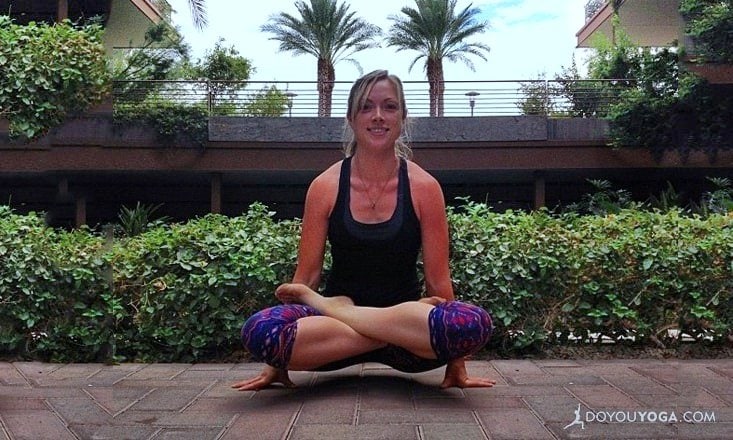Try being fully aware of your pelvic floor. Can you feel it? Are you sure? Many people can’t consciously find, engage, and relax this important group of muscles.
The pelvic floor supports such vital functions as breathing, posture, and physical balance. Its health is key for bladder, bowel, reproductive, and sexual function. Keeping stuff in (including babies, organs, and urine) is an obvious role—regardless of your age, peeing a little when you laugh doesn't have to be inevitable. Most of us don’t pay any attention to our pelvic floor until a dysfunction arises.
Pelvic floor problems (including weakness, tears, and tightness) are associated with sexual dysfunction, incontinence, and even chronic low back pain. However, you can prevent or help such issues by developing awareness of the area.
In yoga, the pelvic floor is thought of in context of the root chakra (“Muladhara” in Sanskrit), which relates to our sexuality and feeling of stability.
Mula Bandha is a yogic practice that involves an engagement of the pelvic floor muscles in order to lock in energy and a build sense of vitality. After I show you my tricks on accessing the pelvic floor, you will be more confident in doing Mula Bandha, and possibly feel more grounded with this new awareness of your root chakra.
Basic Anatomy & Physiology
First, let’s talk anatomy. I painted this picture as if we are looking down from a bird’s eye view at the pelvic bowl to highlight the key muscles of the pelvic floor. You can see that the musculature goes in multiple directions—weaving and overlapping for strength.
Imagine the pelvic floor as a woven basket, holding in all of the vital organs. It needs to be both strong and movable in order to function.
Striking this balance of strength and mobility is key because the body has a natural flow and rhythm. For example, in a healthy and relaxed breath, your abdominal diaphragm (the primary muscle for breathing located right below your lungs and above your vital organs) moves freely up and down. The pelvic floor (often called the pelvic diaphragm) should move freely in unison with it.
As you inhale, both the abdominal and pelvic diaphragm move down—allowing room for the lungs to fill. The organs move down and out slightly, which is why you can feel your belly move with relaxed breathing.
As you exhale, both of the diaphragms move upwards. Therefore, your pelvic floor should be relaxed down in a bowl shape with the inhale, and engage to lift up with the exhale. Let’s put this into practice in our bodies through increased awareness, the lift trick, and intentional engagement.
3 Tricks to Find Your Pelvic Floor
1. Awareness
The first technique is simply increasing awareness to the area. Sit tall and send all of your focus internally to the base of your pelvic bowl. Become an observer of the natural oscillations of your pelvic floor as you breathe.
With the inhale, imagine and feel the pelvic floor naturally descending to allow room for your breath and organs. With the exhale, feel the pelvic floor muscle lifting—gently engaging. Close your eyes and observe for a few moments. You will need to really focus and visualize to feel this subtle phenomenon. If you are not quite sure if you have it, no worries. Go ahead and try trick #2.
2. The Lift Trick
This trick is what made it finally "click" for me. While sitting tall, bring your hands behind you to the floor or seat of the chair. As you exhale, press down so your hips lift up a few inches. Naturally, what you might notice is that the pelvic floor will likely engage as you lift. Do you feel a lightness in the area?
3. Conscious Engagement
The classic description of how to engage the pelvic floor (as done in Kegel exercises) is to imagine you are pausing the flow of urination midstream. Do you feel that lift?
Now, I like to explore a little deeper, based on the advice of my friend, Rebecca Postuma, M.D., who is a pelvic floor reconstruction surgeon and a yoga teacher. This method brings awareness to the posterior part of the pelvic floor. She recommends to imagine holding in a fart. Can you feel the lifting here?
Hold for a few moments. Make sure you are still breathing and not squeezing your butt cheeks; it is only internal and subtle. Now, as you read this, imagine gently releasing the fart in slow motion, relaxing the pelvic floor with control. Do this 3-5 times and then shift back into simply allowing and observing the natural flow of the pelvic floor during relaxed breathing.
These tricks can help you develop awareness, mobility, and subtle strength of the pelvic floor muscles. Make sure to be gentle and breathe while practicing these tricks, or doing Mula Bandha engagement during an asana or meditation practice.
If you ever have a squished up sour face, you have taken it too far. In addition to conscious engagement, make sure you consciously relax the area too.
Image credit: Paige Yeaton



